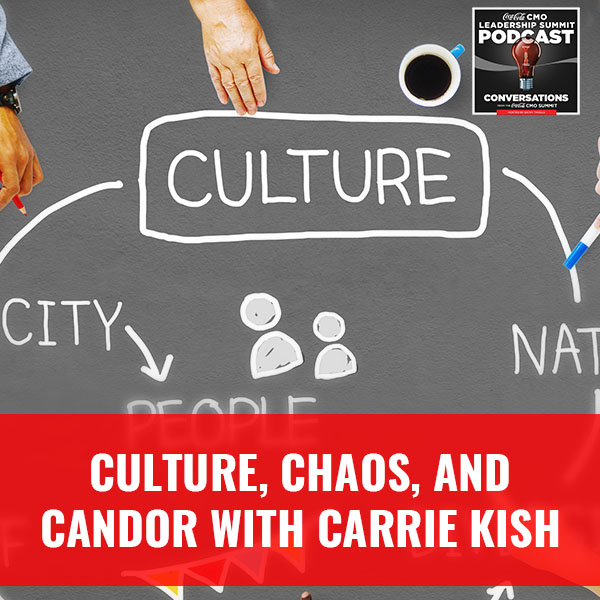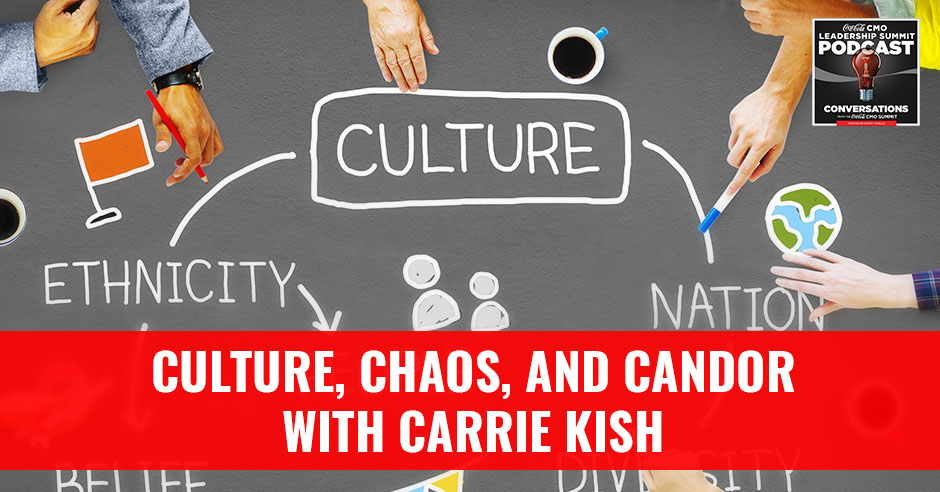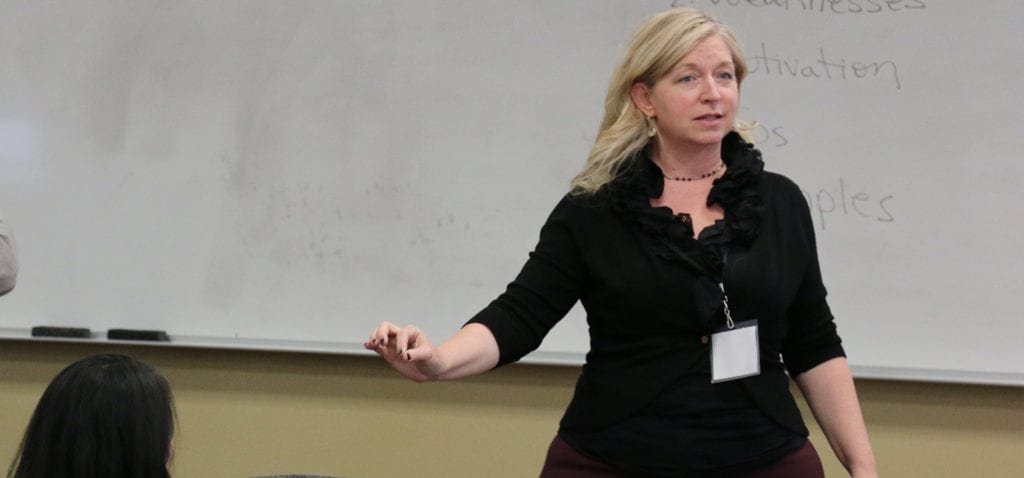Culture, Chaos, And Candor with Carrie Kish


As leaders, we must create strong cultures and that is never a simple proposition. Understanding the dynamics of optimal performance require navigating the complications of the human experience. Our missions can be inspirational, yet they can also include a dark side. Our ability to navigate change and chaos and commitments is a skill that, as leaders, we must learn to master. Are we telling ourselves and others the truth and are we creating cultures that are authentic and powerful? As leaders we must learn to embed thinking time and stillness into our fast-paced lives so that we are more mindful and intentional. Carrie shares her insight on the art of establishing strong culture and self-leadership so that we can be the most effective leaders possible.
—
Listen to the podcast here:
Culture, Chaos, And Candor with Carrie Kish
On this episode, I am speaking with Carrie Kish, Senior Partner and CEO of CultureSync. We’re going to be talking about culture, chaos, candor, commitments and all kinds of alliteration. You’ll find it interesting. To give you a little more background on Carrie, she’s CEO of CultureSync. They are a management consulting firm that specializes in leadership development and culture change. She has over 25 years of experience as a consultant, leadership trainer and a coach. She focuses on the art of leadership for senior executives, physicians and high-impact leaders. She is also a serial entrepreneur and she’s built and sold several businesses over the last twenty years. She has a Master’s Degree in Organizational Psychology and Change Leadership from Columbia University. She’s on the Faculty of the Getty Leadership Institute at Claremont Graduate University and serves on the Faculty of the American College of Physician Leaders. She’s also a Certified Professional Coactive Coach and the past president and executive advisor of the International Coach Federation in LA. She is a mother. She is a volunteer. She is an active seeker, always listening and learning how she can hone her craft and learn more about the evolving landscape of leadership and managing culture shifting in an environment that is ever more complex for all of us. She’s going to share her wisdom and insight and you’re going to enjoy what she has to say with her energy, her laughter, the candor and the journey that she will be taking us on.
—
Carrie, welcome to the show. We’re going to talk a little bit about you. I want you to share the Carrie Kish story, a little bit of background of yourself and how you got to where you are now.
What piece of the Carrie Kish story are you most interested in?
Carrie Kish’s Story Of Leadership And Culture
You are leading an organization that’s all about leadership and culture. As you think about your path, what are some of the key things that pointed you in this direction that landed you in the chair you’re in now?
I ask myself that sometimes and you and your audience ask yourselves. There are some days when I wake up in the morning and I’m like, “How do I find myself here?” I’m a goal-setting kind of girl. My mother says I was born this way. If people meet my mother, they’ll ask her like, “Wow.” She’s like, “No. She just came like that. She’s been setting goals and organizing people and creating things and entrepreneurial since she came out.”
One of the best hallmarks of a leader is that leaders create leaders behind them. Share on XThat’s how we’re made. We just have this thing. I always tell my mom when things get chaotic and crazy, “I’m just going to move to a small town and I’m just going to drink lemonade on the porch,” and she starts laughing. She’s like, “No, you wouldn’t. You would find ten million things to do.”
I’m a mother of four boys and my oldest son is gainfully employed as an engineer in the upwardly mobile part of his career. He’s in his late twenties and he’s married. He called me up with the same thing. He is like, “Mom, this is a lot of work. I’m exhausted and I work my butt off. I’m just going to go and move to some small town somewhere and open a little business and take it easy.” I laughed out loud at him. I’m like, “It’s not in your DNA to do that. You can try. Good luck. You have this problem where your hand will not stay down.” I have that problem and my kids now have it. I do find myself the CEO and Senior Partner of an organization called CultureSync. What we are known for is the workaround tribal leadership and that framework for understanding and developing cultures on teams. We are helping individuals, teams and organizations to be their best, to become their best and perform their best. We take care of their people and that starts by taking care of yourself. We work with everyone from the level of individual to team. I’m a goal-setting kind of girl and being the CEO of CultureSync was never one of my goals. When the team brought me in and said, “We want you to take up the leadership of the organization,” I was shocked. I was more surprised than any of the rest of them were. They all saw it. They said, “You’re already doing it. We just want to formalize it.”
Sometimes your path finds you and people outside of you see that. I’ve had some of those experiences early in my career where I had a manager talk me into moving into leadership and I’m like, “I’m good here.” They’re like, “No, this is where you need to be.”
I want to say that as much as I’m a goal-setting kind of girl and I continue to set goals and I have things that I want to create in my life, whether it’s business or an outcome or a product for our clients, writing a book is something that I find myself immersed in and it is not something that I ever wanted to do. As much as I want to say I’m on a path, I find myself giving this advice more than receiving it. The best advice I give to folks in their careers is, it’s great to cycle. It’s great to have strategic plans. It’s great to have one-year, three-year and five-year plans and pay attention to what’s happening in your life. We’re a little presumptuous in thinking that we can control all of that and that we can even see all of that. Repeatedly, one of the things I had to learn is just to say yes to the things I’m being asked to do. That keeps happening.

Strong Culture: It’s really easy to say yes to good things and no to bad things.
In addition to being a mom, being married for almost 30 years, which I’m very proud of, that’s a huge leadership exercise. I also have a leadership role in my church. At the same time that I took up the role of Senior Partner of CultureSync, I was asked to step into a leadership role at my church. I am now the Spiritual Director for 97 people. I said, “No, I can’t do that. I travel. My travel schedule is crazy. My mission is focused outside of here. I don’t have time.” My priest calls me and says, “Can we just talk about it?” I said, “I’m happy to talk about it.” I show up into his office to talk about it and he handles all my objections and then he shakes my hand and gives me a hug and said, “It is such a blessing to have you in this ministry and we’re just going to really enjoy working together.” I walked out of there and I’m like, “I just got boondoggled by my priest.” I was like, “I said no and here I am. I’m in-charge.”
Were you in the program? At the same time, you’re also doing this leadership education. They say, “If you want something done, give it to a busy person.” All leaders face this. How do you balance the yes and the no? There’s such a power in stepping into the things that show up for you. Then there are times when you say too many yeses and you can’t be in all those places and you find that you’re everywhere and nowhere. How have you balanced the yes and the no?
For me, I find that a consistent pendulum swing. In my life, if I find myself with any amount of space, I started looking for more or more finds me. I’m sure you and your audience can relate to that. Then I get to the point where I’ve said yes to too many things and now I’m overburdened and over-committed. All of those yeses caused me now to look for the things that I have to let go of in order to up-level my leadership and my life and to make a bigger contribution. It was hard to discover and this is advice that I have to give to my clients all the time. It’s easy to say yes to good things and no to bad things. Those are easy decisions at this point in our careers or at the point between saying yes to great things and no to great things. It’s not even like, “That’s clearly great and this is just good.” It’s like looking at all of the things and going, “I have ten amazing things in my life and I need to create more boundaries with these ten things. I need to move two of them off.” One of the best hallmarks of a leader is that leaders create leaders behind them. One of the things that I am most proud of is having created things behind me that are sustaining themselves that I have moved on from. There are leaders now in charge that were able to step up behind me. That’s something I’m very passionate about with all the leaders I work with is, “What is your succession plan?” We should always be working on developing the people who come to us.
Leadership oftentimes is about inserting more chaos into the system. Share on XDo you find people are doing that very often or not?
No, it’s a huge blind spot.
Pitfalls Of Companies In Developing Leadership And Culture
Talk to us more about that. You’re engaging in so many conversations with different organizations and developing their leadership and developing their culture. What do you see are the pitfalls that you come across most often that companies are doing to not nurture those things?
There are a lot of tensions in organizations and as leaders, early in our careers, we’re taught to resolve conflict and resolve tension and fix problems. We get to a certain point in our leadership and if you haven’t gotten there yet, it’s something to look at. It’s not resolving tension but holding tension. It’s not this or that, it’s this and that and how can we have it be this and that? Both things. One of the tensions I see in organizations is the tension between management and leadership and that there is such a drive towards heavily managed companies. Most organizations we go into are overmanaged and under-led. We have all these management activities. How do we measure this? How do we implement this? What are our KPIs? There is such a demand on companies from the market and from the customer or the consumer to perform. They were very performance-oriented. There’s this drive for performance and we’re losing the being and the mission. We’re overdoing and under being.
I’d love to explore that a little deeper because that’s such an interesting comment. Working in Corporate America, we’re very metrics-driven. Wall Street is metrics-driven. What are you doing? I need to see your success. I was in a conversation with someone who was talking about how they run this high-end safari place. They talked about, and it’s very culture-centric, the nature of what they’re cultivating over time with their people. What they’re thinking about are the seeds they’re planting now that’s going to germinate many years into the future. They talked about the fact that so much of their success was from things that could not be truly measured until you looked back. If you’re a public company or even an associate of an organization that is expected to see metrics, how do you balance that intuitive knowing like, “This is the right thing to do versus this is what can be measured?”

Strong Culture: If you don’t shine a light on some of the core destructive things that are happening in an organization, they can eat the organization alive.
That’s a tension that we have to learn to hold. I am not coming here to tell anybody that they need to start measuring their success or that they don’t need to perform to the market standards or the industry standards or all the demands that are put on them. We’re so focused on that demand and there’s a backlash right now in the industry. It has been performance at all costs. Performance at all costs gets you the types of things we’re seeing coming out of Hollywood like the #MeToo Movement. It’s getting us the things like what is happening at USC where you’ve got the former Dean of the medical school performing at all costs and people looking away. We’ve got things like, “What is happening in the Catholic Church?” We are not taking care of problems that need to be taken care of because there’s a superordinate goal. The superordinate goal is whatever it happens to be. We have to start looking away from some of the issues that are coming up underneath. The humans underneath the system are saying, “We can’t tolerate that anymore.” You’re seeing all this bubbling up in the culture like we have to start taking care of the soft stuff. We have to start taking care of the culture and the humans and the people. We have to start addressing the dark side of what’s going on in organizations and in the world and not just be focused on performance. Performance at all costs is becoming too expensive and we won’t tolerate it anymore.
It’s super interesting because when people think of culture, there’s the leadership conversation and there’s the culture conversation. Some people think that’s the nice, happy space. Your comment about the dark side or the seedy underbelly of all of that is if you don’t shine a light on some of the core destructive things that are happening in an organization, they can absolutely eat the organization alive if we’re not aware of it and we’re trying to stay up here. Some of these other metric-based conversations are also very short-term when you might have something brewing that could create real problems for your long-term growth. How have you managed that with not only CultureSync and making sure that you’re operating at the highest levels, but with all the clients you work with on how to manage that tension?
As individuals and on our teams and as leaders, many of us find ourselves being aspirational. These are the things I aspire to. It’s values-based and it is mission-driven. There’s a lot of positive energy around that. What we’re starting look at is that there is a dark side to all of that. There’s even a dark side to your mission. I’ll give you an example. I won’t shout out the organization. One of our clients is an organization and they’re doing great work and their mission is to serve the poor and underserved in their community in a very particular way. That mission causes them to be very diverse. It causes them to employ people that are less technically competent or less educated than the market would demand. It also causes these weird things to happen in their organization. They overcorrect on taking care of the employee and so the organization is suffering a lot. They don’t have real healthy leadership and they have a real hard time holding people accountable because of this mission. That’s the dark side, the underbelly of that mission.
I’m working with another organization that’s entrepreneurial and values transparency. This organization values transparency and the dark side of that is sometimes people use the value of transparency to say things that are unkind and to come at people too fast, too hard under the umbrella of transparency, “I’m just telling you the truth.” “You need to tell the truth responsibly. You need to take care of people.” Those are some examples of there’s a dark side of the mission. There’s a dark side to each value. Each value is a whole, just like a human. People are more complex than a value but if you look at one word, what we tend to do is only look at the aspirational side of the word. We don’t look at the full complexity of the word. The full complexity of the language informs what’s happening in our culture. We can go, “That’s interesting.” We don’t have to take it away. We just need to notice it and be able to talk about it.
The more chaos you can tolerate, the more success you'll have. Share on XOne of the things that came up for me is we were talking about networks and the type of people you need to have in your life. One of those individual groups are the truth tellers. To your point about this value of taking care and certainly we all want to practice kindness and compassion in our work, what happens when no one’s telling the truth about real conflicts and real challenges?
That happens all the time. A value that drives that is there are values of kindness, there are values of respect, “I’m going to be respectful.” People mean different things by that. If I respect you, in some cultures that means I’m not going to challenge you. I can’t tell you the real truth. What happens in cultures like that is you see this gossip going around. People don’t tell the truth to each other’s space, but they talk behind each other’s back. It’s very polite. It’s very kind. It’s very respectful, but there’s this insidious underbelly. We do need the truth tellers. We do need the people who are going to say respect is a bigger word and under the guise of respect, “I respect you, so I’m going to tell you the truth.” That means up-leveling our values. When you were saying nice and good, there are these defaults to being kind, to being nice, to being appropriate and to being respectful as the goal in business. What people often misunderstand when they’re engaging with us and the tribal leadership framework is that when you move from stage to stage, you’re going to get better results.
There’s an assumption that as we move from stage to stage, people will be nicer and that it will be rainbows and unicorns. We’ll be skipping through the daisies and singing Kumbaya and it’s going to be this great lovefest. It is so not that at all. I’ve marched into CEO offices all the time and they say, “Carrie, this stuff is not working, all these things you’ve been teaching us. It’s crazy around here. It’s chaos.” I’m like, “We did not promise that it was going to be less chaotic. We did not promise that it was going to be nicer. What we promised is you’re going to get better results. You’re going to move faster and you’re going to be based on values as opposed to based in expertise.” You need to bring your expertise with into the values-based conversation. When people are talking about values, they feel much more passionately. People are much more engaged, but they’re also in more conflict. You’re going to have more chaos.
Navigating Chaos
I have to jump in on this because you joined us for the Summit a few years ago when our theme was navigating the chaos. One of the comments that you made was that people often think of chaos as something to be feared or avoid it and that there’s an opportunity to use chaos as a strategy. You were touching on that. Go a little bit deeper into this whole idea of chaos as a strategy.

Strong Culture: In order to be radically present, you have to be absent from other things.
It brings us back to the concepts of management versus leadership. Management is pulling the chaos out of the system and organizing things. It’s putting things in place and building structures so that there’s less chaos. Leadership oftentimes is about inserting more chaos into the system. It’s harnessing creative energy. People can put a negative context on chaos because you can’t control it. By its nature, you cannot control it and we want to be able to control things because then we feel like we are in-charge. Being able to strategically allow some chaos in your conversations, on your teams and in your personal life just to be able to allow some chaos. The advice I’d like to give people is the more chaos you can tolerate, the more success you’ll have. There are different ways of looking at that. People need certainty. Control, certainty containers to put things in and ways to organize and understand things. Those are great except they are limiting. By putting things into containers, by controlling things, you can only get as much as you can see. By allowing some chaos, you find yourself in places you never thought you’d be. You have access to resources and information and people in your network and ideas and concepts that you never had access to before. You’re not trying to control things and you have the ability to leave things unsolved and unresolved.
It’s such an interesting dynamic with human beings. We do crave certainty. It’s this protective thing, yet at the same time, and almost paradoxically, we crave variety and newness and something that’s going to make it interesting for us. There is a lot of research that big breakthroughs, big creative changes happen right after moments of chaos. It’s very cyclical. Things go crazy.
You even look at nature for an example of that. It’s out of the chaos that something new is born.
Staying on this topic of chaos but pivoting only slightly, at the Summit, we were talking about this deluge of information that human beings now have to assimilate. I don’t know if this fact is correct, so I’m just going to throw it out there. Someone had said that we take in more in a day than Shakespeare did in his entire lifetime due to the access to data that we have and everything that’s hitting us. We’ve talked a lot about this idea of connections to other people and social media and all this, but not losing ourselves and losing our humanity. We’re becoming so fragmented and almost ADD that we can’t be present to each other. What’s been your experience as a leader with that dynamics?
It is out of chaos that something new is born. Share on XI’m going to tell you personally, I’ve had to do a lot of work there. One of the things that I’m committed to is radical presence. In order to be radically present, that means you have to be absent from other things. That’s the dark side of that. I have to be very strategic and as leaders, we all have to be very strategic on how we curate our information. What do we choose to take in and what is meaningful for us? It’s to understand and appreciate the kind of information we’re interacting with and what it’s giving us. For some people, watching the news is an important part of their job. Staying up-to-date on current events, that’s an important part of their life. That’s how they interact with their community. That’s how they interact with their social circles and their network and they need that context to be able to do that. For other people, watching the news is entertainment. Most people that watch the news for entertainment don’t think of it as entertainment. They can justify it as, “I’m staying up-to-date,” or whatever it happens to be.
For some people, watching the news is incredibly destructive. I happen to be one of those people. I don’t read the newspaper. I don’t watch the news. I engage strategically with social media. I was super addicted to Facebook and then when Twitter first came out, I did a little foray into Twitter and I literally lost 72 hours of my life on Twitter. It’s like crack. I was addicted to it. I was like, “That’s scary.” I immediately left Twitter because I was like, “That was whoa.” I’m a Catholic. One year for Lent, I gave up Facebook for 40 days. I was like, “The amount of life I got back from that exercise.” As a Catholic, I have this ritual structure in my life for giving up something. It’s something that is distracting me from being present or distracting me from whatever superordinate goals I might have. An exercise that I invite anybody into is if there’s something in your life, it could be the newspaper, notifications on your phone, social media, alcohol, working out, we all use certain things. For that, we have these vehicles to meet a lot of our needs and to stay engaged with our community. An exercise that’s very interesting is taking a break from a vehicle for 21 days, three weeks. It doesn’t have to be six weeks or 40 days or anything like that but take a break and see what emerges. That’s an interesting exercise.
It is because it interrupts the patterns that we are in. What’s fascinating for me as we’re talking about this, you mentioned when space opens up, you immediately either find something to fill it or it finds you. It’s like cleaning out your closet. When something comes in, other things go out. What I have been fascinated with lately and observing even in myself is, “How do I create enough space in my life where I can be in that space and not automatically fill it because that is going back to DNA?” That’s our nature. Fill it but to linger in that open space, see what comes in that’s more creative and more reflective that might alter my trajectory in a bigger way than another accountability or another activity.
That is so counterintuitive in the business world. We don’t do that and we don’t acknowledge that it’s useful. If I had an appointment on my calendar every day for that purpose, no one else in my world would honor it. There are some folks who are good at that. In our faith’s traditions, we see a lot of that, taking time for reflection or even in some physical activities. Yoga has meditation built-in. Meditation and mindfulness, these are things that are emerging into the business world. Warren Buffett has a practice called thinking time. He puts it on his calendar, Time To Think, and he won’t make decisions without thinking on them first. A friend of mine was sitting in a meeting with Warren Buffett and his EA walked in at a break and said, “So and so is asking for a decision on this.” He looks at his calendar and he says, “I won’t be able to give them a decision on that until Thursday at 5:00.” She says, “Okay,” and she walks out. My friend says, “Why Thursday at 5:00?” He says, “I don’t have time to think about it before then.”

Strong Culture: Slow down to go fast.
We don’t ask each other for time to think and we don’t create time to think. If you look at the ways that you can use your time and spend it, we are good at that. We are not super good at saving it, but I like to think of activities like that as investing. There are all kinds of research about spending time in meditation or in thinking strategically. In business, we have some cadence like strategic planning meetings or corporate retreats or the CMO Summit. There are cadences of time where we are pulling ourselves off of the treadmill and out of our daily operations in order to think. I can’t personally take time out to think, but I can schedule this meeting to think with others. This is how it gets put into operation in the business world is, “I have meetings,” and they are for the purpose of thinking with others. It is incredibly valuable for us to take time out personally, individually, and as teams and organizations to think and pause and reflect. It’s one of the things that we teach. One of the best investments you can make as a leader is to invest in reflection time or mindfulness or thinking time or whatever it is you happen to call it.
Isn’t it so interesting, especially if you’re used to the fast pace, to allow it? There are a lot of beliefs connected to this. Whether it is, “I’m guilty because I have to be productive and this isn’t productive,” it is absolutely incredibly productive because to your point, it’s investing in the future yet we’re also uncomfortable. Even being in a conversation, if you allow silence, a space in a conversation, someone stops talking and you just let it linger for a minute. People start to squirm like we have to fill, fill, fill. One of my hypotheses for this new age that we’re living in is that the people who can create enough space for discernment and valuable value-based choices in their lives and not get caught up in the swell of information. They will be the people that will emerge as the greatest leaders because of their ability to do it.
I’m seeing the evidence of that out in the business place. For example, I coach a lot of CEOs. The best CEOs are very consistent in keeping their appointments. They’re not running around with their hair on fire. They have no problem sitting down and spending an hour every two weeks with me. I have another client who is upwardly mobile in her career. She’s a top producer, high performer and she cannot find an hour for me. In order to give me an hour, she has to take it from herself or her kids. We can all relate to that. I know I can. The thing for me to realize is slow down to go fast. We do have practices in our lives. When I look at these successful CEO types in different organizations, whether they’re CEOs or CMOs or other top performers in organizations, when I look at them, the successful ones have practices that allow them to think. Some people run and some people journal.
When I tell people, “You need to have a mindfulness practice,” their heads might explode like, “You want me to sit and cross my legs and say ‘Om’ for 60 minutes? No, I’m not doing that. I can’t do that. My head will explode.” It’s like, “What can you do? Can you get on the treadmill for twenty minutes? Can you soak in the bath? Can you listen to music?” For me, I live in LA. I spend a lot of time on the freeway. I balance that time between personal calls. I don’t take client calls in my car, but I have four kids and they live in four different states. Either catching up with my kids or my mother, I will do that in my car. Consuming information. I’m an active learner. Listening to podcasts is something I’d like to do. I might listen to a podcast. I also love listening to music, so I might listen to music. The other thing that I do that I don’t think people keep in their rotation enough is sit in silence. I spend at least a half an hour my drive time in silence every day, sometimes twice a day because I need the space. People need to think about like, “How can I put this practice into my life, so it makes sense to me?” as opposed to like, “That’s not accessible. I’m not doing yoga or I’m not going to the gym,” or whatever it happens to be. Another practice I love is cooking. For me, cooking is meditative activity.
You learn more from your failures than your successes. Share on XI love thinking about this type of thing because I do think it’s lacking as things move faster and it’s all about belief systems. Excuses might be a bit of a strong word but it is this, “I can’t, because.”
Anytime you find yourself saying that to someone else or hearing it from someone else, anytime I hear an, “I can’t,” for myself, especially if it’s an opportunity or it’s an invitation to interrogate my beliefs, it’s like, “What do I believe about it that makes that a no?” “No, I can’t do that thing at church. I don’t have time.” Time and money are two excuses that we let people off the hook on all the time. I have to think, “What am I valuing more than that time? What’s the opportunity creating here for me? How could I think about this differently? What might I need to have more boundaries around? What might I need to say no to? Who might I need to get into a relationship with? What kind of support might I need?” These are the questions that I might ask instead.
Mission, Vision, And Values
That’s all part of the reflection and the thinking time. There are times when there is a legitimate no, but how do we place prioritization on these activities? Some of the things that might push our edge or make us a little bit more uncomfortable, we might be very quick to say, “I can’t,” because we aren’t asking those questions about how that action might change us or pivot us to a different way of being and a different way of thinking.
For organizations, it’s popular for us to be talking about values and mission at this point. Mission, vision and values, we’re talking about that. We’ve gotten away from talking about it personally. People may know their personal values. You especially know your values when they’ve been violated, but I don’t know that people spend a lot of time thinking about their mission. It’s hard to think about it. That is one of the things that I continue to think about is, “What is my mission here on this planet? What am I here to do?” I remember a training program that I was involved in and one of the graduation questions was you had to answer this prompt, “I was born in this time in history to do, or I was born at this time in history,” and you have to answer that for five minutes. “I choose at this time in history to.” It’s, “Do, be, have,” or whatever that happens to be. When I look at those opportunities that I want to look to say yes or no to and I filter it or I explore it through the lens and my values. I explore it through the lens of my vision and I explore it through the lens of the mission. Then I have to say, “Is there a calling?” I spend some time in discernment. Clearly, I’m being called to do something that I didn’t realize I was here for. I’m called to serve in a way that I didn’t realize and that causes me to up-level and I have to let go of some other things that are no longer serving me or serving the world as powerfully.

Strong Culture: If we’re not failing, we’re not trying hard enough.
Leadership Role At CultureSync
Sometimes I’ve thought about it as it’s the intersection of where you put yourself and where you find yourself. There’s a plan that you have this intention, this aspiration and you start taking one step and then the next step, but everything is always emerging. If you are completely in tune with that, I call it the inner compass. You have to invest to your point in that upfront reflection time of what matters because there will be value conflicts where you’re presented with two different roads, two different values and you’ve got to pick the one that is more important. If you haven’t done the work, you’ll find yourself a bit in a quandary. Doing that is so important. You have talked to all these people on the podcast, you’ve worked with all these clients and you’ve been on your own journey. You mentioned that you didn’t see yourself initially in the leadership role at CultureSync. The company has evolved and you’ve evolved. It’s one thing to talk theoretically about leadership and we do a lot of that, but what have you learned from your most personal challenges as being a leader to others and becoming a ground leader? What can you share about that?
Two things come to mind and they’re closely linked. I have learned more from my failures than from my successes. I feel like we spend our lives trying to avoid failure like, “I don’t want the people on my team to fail,” and I want to set them up to succeed. I don’t want to set them up to fail. That’s not my goal is to set anybody up to fail, but I do need to allow people to fail. My kids are a great example of that. I’ve learned more about watching my kids fail and not being able to rescue them. That has been so incredibly hard not being able to save them from their lives. One of the things that I have to continually remind myself is, “What I don’t know is a lot more interesting than what I do know.” People want to know what you know and we’re in the habit of telling people what we know. Asking questions is much more interesting than having answers and then to be a constant learner. I’ve always been a voracious learner, but only because I am so committed to learning. I find so much worthy value in my failures. It’s because they point me to learning more than anything else does. It’s easy to learn in the comfort of your successes, but you must learn from the discomfort of your failures.
We’ve talked a lot in Coke about how we want to shift our culture and become a culture that is a growth mindset. A growth mindset demands. I know Carol Dweck talks a lot about this.
The tension between performance and growth or performance and learning.
Asking questions is much more interesting than having answers. Share on XWe were talking to everyone in our company about this idea of failing forward. I know that’s a cliché term. How do you push your edge enough and ask enough new questions to feel comfortable failing? It doesn’t mean they aren’t smart risks. You’re still moving forward with the greatest of intentions to find success but if we don’t allow that failure, if we don’t model that failure in our cultures, there is no way we’re going to reach the levels of innovation and creativity that we need to compete in this new world.
If we’re not failing, we’re not trying hard enough. We’re not taking enough risks. One of the things in leadership roles that we need to do is make sure we’re creating a safe environment and making it psychologically safe for people to fail. In most organizations I work in, it’s not. That failure gets weaponized and used against people or it becomes the thing that leads to their exit. I will give you a personal example from our team. I had somebody on my team who is going to work with one of our clients and he was walking into a very difficult situation. He was calling me to talk through the data and the information and the presentation. I said, “I want you to know two things as you go into this. You have permission to fire the client and you have permission to be fired by the client. I have your back.” If you get fired or you fire them, I will celebrate that with you. Then he can go in and do what he needs to do. They got more value out of that meeting with him than they’ve gotten out of ten other meetings with him because he was able to show up knowing that he could fail and knowing that failure was an option.
It creates an authentic conversation because as much as we want to create this image of perfection, especially as we become leaders, the fact is we’re all still learning and we’re all figuring it out. Everything’s changing around us. Something that you may have known before or been an expert in before is now the rules have all changed. Then how do you respond to that? What I have to say is being in the conversation, the Summit is about community. We are a community of help because of what I said. No one person has all the answers and no one person is ever going to get there by themselves. This is about us in conversation. Whether it’s this podcast or when we’re together at the Summit or we share a lunch or we have a group of people together, there’s so much that happens out of that. Can you think about all of the journeys we’ve been on as leaders, anything you would leave this community with as far as the power of learning from each other, the power of being connected and how important that is in shaping our future?
If I had only one piece of advice, it would be to be yourself. I know that sounds like a cliché, but we’re spending so much time being who we think other people need us to be. We’re discovering who we are and I know I learn more about myself in every failure, in every success, in every new opportunity I step into, and in every new relationship I’m in. Constantly be in that space of learning who you are. It brings us full circle. I’m going to ask you, “Tell a little bit about yourself,” and I’m like, “I have no idea who I am now.” Give yourself permission to be that multifaceted, gorgeous diamond of a self and to emerge and shine.
I could not think of more powerful words to end this. Carrie, I want to thank you for your wisdom and your leadership and your friendship. You always bring out new ways to think about life when I’m in conversation with you. Thank you so much.
Thank you for having me as a guest. You’re generous and gorgeous as always.
Thanks, Carrie.
Important Links:
About Carrie Kish

Carrie Kish is the Senior Partner and CEO of CultureSync, a management consulting firm that specializes in leadership development and culture change.
Carrie has over 25 years experience as a consultant, a leadership trainer and a coach who specializes in leadership training for senior executives, physicians, and high impact leaders. She is a serial entrepreneur who has built and sold several businesses over the last 20 years, the last one for 8 figures.
Carrie has a master’s degree in Organizational Psychology and Change Leadership from Columbia University. She is on the faculty of the Getty Leadership Institute at Claremont Graduate University and serves on the faculty of the American College of Physician Leaders. Carrie is a CTI Leadership Graduate, a Mastery University Graduate, a Leadership Mastery Graduate and a UCLA Graduate. She is also a Certified Professional Co-Active Coach and the Past President and Executive Advisor of The International Coach Federation in Los Angeles.
Carrie is a teacher, speaker, and coach to senior executives, physician leaders, entrepreneurs, engineers, nonprofit leaders, and museum executives. She has experience working with executives, companies, and teams as diverse as Microsoft, Virgin Galactic, Coca Cola, The San Antonio Spurs, UNLV Medical School, DaVita Healthcare Partners, The Chinese Museum Association, The World Bank, Zappos, and the California Medical Association.
Carrie lives in Los Angeles, California with her husband of 30 years. They have 4 sons and two dogs. She thinks that being a wife and a mother may qualify her as a leader more than any of her other credentials. Carrie is actively researching and writing her first book on the Dark Side of Leadership.
chaos, culture, culture dynamics, CultureSync, leadership, self-leadership
Love the show? Subscribe, rate, review, and share!
Join The Coca-Cola CMO Leadership Summit Podcast community today: